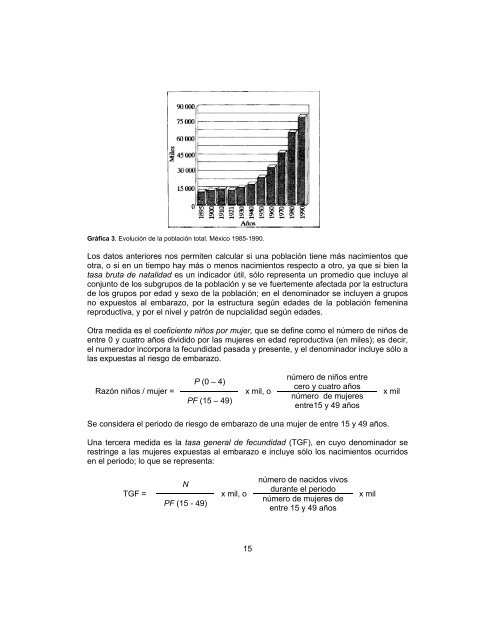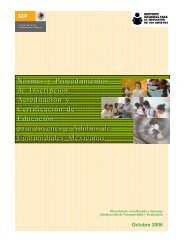ciencias de la salud ii - Portal Educativo Washington State CONEVyT
ciencias de la salud ii - Portal Educativo Washington State CONEVyT
ciencias de la salud ii - Portal Educativo Washington State CONEVyT
You also want an ePaper? Increase the reach of your titles
YUMPU automatically turns print PDFs into web optimized ePapers that Google loves.
Gráfica 3. Evolución <strong>de</strong> <strong>la</strong> pob<strong>la</strong>ción total. México 1985-1990.<br />
Los datos anteriores nos permiten calcu<strong>la</strong>r si una pob<strong>la</strong>ción tiene más nacimientos que<br />
otra, o si en un tiempo hay más o menos nacimientos respecto a otro, ya que si bien <strong>la</strong><br />
tasa bruta <strong>de</strong> natalidad es un indicador útil, sólo representa un promedio que incluye al<br />
conjunto <strong>de</strong> los subgrupos <strong>de</strong> <strong>la</strong> pob<strong>la</strong>ción y se ve fuertemente afectada por <strong>la</strong> estructura<br />
<strong>de</strong> los grupos por edad y sexo <strong>de</strong> <strong>la</strong> pob<strong>la</strong>ción; en el <strong>de</strong>nominador se incluyen a grupos<br />
no expuestos al embarazo, por <strong>la</strong> estructura según eda<strong>de</strong>s <strong>de</strong> <strong>la</strong> pob<strong>la</strong>ción femenina<br />
reproductiva, y por el nivel y patrón <strong>de</strong> nupcialidad según eda<strong>de</strong>s.<br />
Otra medida es el coeficiente niños por mujer, que se <strong>de</strong>fine como el número <strong>de</strong> niños <strong>de</strong><br />
entre 0 y cuatro años dividido por <strong>la</strong>s mujeres en edad reproductiva (en miles); es <strong>de</strong>cir,<br />
el numerador incorpora <strong>la</strong> fecundidad pasada y presente, y el <strong>de</strong>nominador incluye sólo a<br />
<strong>la</strong>s expuestas al riesgo <strong>de</strong> embarazo.<br />
Razón niños / mujer =<br />
P (0 – 4)<br />
PF (15 – 49)<br />
x mil, o<br />
número <strong>de</strong> niños entre<br />
cero y cuatro años<br />
número <strong>de</strong> mujeres<br />
entre15 y 49 años<br />
x mil<br />
Se consi<strong>de</strong>ra el periodo <strong>de</strong> riesgo <strong>de</strong> embarazo <strong>de</strong> una mujer <strong>de</strong> entre 15 y 49 años.<br />
Una tercera medida es <strong>la</strong> tasa general <strong>de</strong> fecundidad (TGF), en cuyo <strong>de</strong>nominador se<br />
restringe a <strong>la</strong>s mujeres expuestas al embarazo e incluye sólo los nacimientos ocurridos<br />
en el periodo; lo que se representa:<br />
TGF =<br />
N<br />
PF (15 - 49)<br />
x mil, o<br />
número <strong>de</strong> nacidos vivos<br />
durante el periodo<br />
número <strong>de</strong> mujeres <strong>de</strong><br />
entre 15 y 49 años<br />
x mil<br />
15
















